Volunteers along with KSA Built have put in two new features on Furlough.
Name this feature by sending pinehillpartnership@gmail.com an email with ‘name that feature’ in the subject line.
Winner gets a choice of Pine Hill Partnership t-shirt or hat.
Volunteers along with KSA Built have put in two new features on Furlough.
Name this feature by sending pinehillpartnership@gmail.com an email with ‘name that feature’ in the subject line.
Winner gets a choice of Pine Hill Partnership t-shirt or hat.
by Tom Estill
Near the first day of spring, 2024, a major snow storm came through the area and dumped about 18” of snow on the ground. On a late afternoon walk the forest was relatively quiet with just a few birds seen including, yellow-crowned kinglet, tufted titmouse, crow, black-capped
chickadee, white-breasted nuthatch, and a turkey vulture flying overhead. On March 26th, snow continued to melt, but it was still very deep. I was hoping to see some of the first migrants to arrive, but saw only tufted titmouse, pileated and downy woodpeckers, crown, white-breasted nuthatch and a red squirrel near the trailhead.
On a March 28th hike, snow was melting rapidly, with bare ground becoming a more and more common sight. A good day for birdwatching with a cardinal, mourning dove, Carolina wren, dark-eyed junco, tufted titmouse, black-capped chickadee, American goldfinch feeding on birch catkins, crow, golden-crowned kinglet, white-breasted nuthatch, ruffed grouse, and pileated woodpecker, all being seen.
On March 30, the first wildflower of the season was seen flowering where it’s always seen-in the wetland areas adjacent to the boardwalk near the trailhead. That flower is, of course, COLTSFOOT. Also, on this day was seen the first migrating warbler, the black and white warbler. Dark-eyed juncos were chasing one another, establishing their territories, and a few Canada geese were sitting on their nests on the little islands on the west side of Muddy Pond.
Also, on the pond were a few pairs of mallards, and about a dozen common mergansers. It felt like an early spring day.
On the last day of March, a Cooper’s hawk was seen bringing nesting material to a nest it was building near the Lower Giorgetti trail, close to where last year’s Cooper’s Hawk nest was located, but which has since been abandoned. A second Cooper’s Hawk was seen perching near the nest they were building.
By the first day of April, Eastern chipmunks were out and about in large numbers, a red squirrel had set up a nest near the trailhead, the first butterfly of the season was seen, the Mourning Cloak(always the first!), and always seen in the few open areas in the park where the American chestnut trees were planted in the past, flying insects were becoming more numerous, many painted turtles were sunning themselves at both Muddy and Rocky Pond, and one Osprey was seen on its nest at Muddy Pond.
The second week of April found mostly sunny days with temperatures in the mid-60s. An Eastern phoebe was seen flying in and out of one of the abandoned quarry buildings on Crusher Rd. I could see its nest high up on an overhang near the ceiling. The same place it’s been making its nest for years. Numerous bluebirds also seen near the quarry. Hundreds of wood frogs croaking in the wetland area at the south end of Rocky Pond.
By the second week of April, trailing arbutus was flowering (always second after Coltsfoot), the Hermit Thrush had returned and Trout Lily leaves were beginning to emerge from the forest floor. On the 14th, yellow-bellied sapsucker was back and drumming, while on Muddy Pond, 2 Osprey were seen on and near their pole extension nest.
A day later a doe, and 2 yearlings accompanying her, were seen on Droopy Muffin trail. They would be seen numerous times in the following weeks. Two adult Canada Geese had set up nests on the west side islands on Muddy Pond. They obviously were sitting on eggs, because every time I checked the nests, they’d be sitting there, while their mate was nearby keeping strangers away.
On April 16th, I was surprised at how quiet the forest had become and I saw but a few birds including cardinal, tufted titmouse, white-breasted nuthatch, and Bluebirds flying in and out of the next they had recently occupied at the top of a dead white birch adjacent to quarry buildings.
During the third week of April, wood anemones were flowering, one of the Cooper’s Hawk was continually sitting low on its nest, very likely keeping its eggs warm, a brown creeper was seen bringing nesting material to its recently constructed nest, a solitary vireo was seen, and the bluebirds were seen flying continually in and out of their birch tree nest.
By the last week of April, trout lily were in flower, black-capped chickadees could be seen feeding on red pine seeds, belted kingfishers had returned to the ponds, bumblebees were out in large numbers, bellwort and sedges were in flower along with various violets, many bullfrogs and green frogs were calling at the ponds, and fiddleheads were opening,
During the first week of May, Dave Jenne, Shelley Lutz and myself went on a 5 hr. birdwalk and saw black-capped chickadees, crow, American goldfinch, tufted titmouse, downy woodpecker, cardinal, Carolina wren, white-breasted nuthatch, robin, brown creeper, American redstart, ovenbird, blue headed vireo, least flycatcher, northern flicker, Eastern phoebe, great crested flycatcher, field sparrow, hermit thrush, Eastern bluebird, hairy woodpecker, yellow-bellied woodpecker, black-throated green warbler, Eastern towhee, blue jay, black-throated blue warbler, red crossbill, black and white warbler, catbird, and white-throated sparrow. At Muddy Pond could be found many painted turtles sunning themselves, Canada geese nesting, and Common Mergansers. Catkins were hanging from the limbs of white birch trees.
During the second week of May, Moccasin flowers, Gay wings, star flowers, foam flower, butter and eggs, wood betony and pale corydalis were all blooming. Numerous reports of a sow and accompanying young bear seen at south side of park, adjacent to residential area. Female Cooper’s Hawk appears to be feeding young. Scarlet tanagers had returned, and after a rain, numerous red efts could be seen on the trails. Had to be careful where I put my foot. By this time of year, emerging tree leaves are making it harder to see birds higher up. Indigo buntings were back in numbers I have never seen before, red-wing blackbirds were nesting at Rocky Pond, ruby-throated hummingbirds were seen for the first time this season, and
Jack-In-The-Pulpit was blooming.
During the third week of May, I saw my first yellow warbler this season, while chestnut-sided warblers, red-eyed vireos, American redstart, black-and-white warbler, tufted titmouse, Eastern wood pewee, indigo buntings, northern cardinals, Carolina wren, veery, common yellowthroat, black-capped chickadee, least flycatcher, osprey and Canada geese were regularly heard or seen on just about every walk I went on in the park.
The last week of May I saw my first northern parula and cedar waxwing of the season.
Forget-me-not, Common buttercups, red clover, blackberries, fleabane, blue-eyed grass, and hawkweed were all blooming, and evergreen pollen was covering the perimeter of both Rocky and Muddy Ponds. The red admiral butterfly was seen under the power lines on the Carriage Trail, a place where I see them every year.
During early June, Field Cow Wheat, Tufted loosestrife, and Blue Flag were all flowering. And on June 7th, I replaced two dead American Chestnut trees with American Chestnut seedlings, and saw a beautiful Hummingbird Clearwing Moth. In Mid-June, the inevitable finally happened after 12 years of walking all around Pine Hill Park, observing the wildlife and planting trees and wildflowers-I was diagnosed with Lyme Disease. And it knocked me flat for at least two weeks. So, I’m ending my report here.
Hope you enjoyed this summary. Please remember to stay on the trails, and enjoy watching the Wildlife of Pine Hill Park.
by Tom Estill
We are so fortunate to have Tom checking on our wildlife through out the seasons and write up a great report for us.
During the week of the Winter Solstice of 2023, the forest was relatively quiet with Rocky Pond finally completely freezing over, though with thin ice, on Dec. 23rd. So quiet, that on that day of Dec.23rd, I didn’t hear or see a single bird on my walk to and from Rocky Pond, a very rare occurrence for me.
A few days later on a walk to Muddy Pond, I saw 4 flocks of about 12 Canada geese flying low towards Muddy Pond, white-breasted nuthatch, and black-capped chickadees.Both ponds were completely frozen over with thin ice, with the exception of a few small areas near the shores of both ponds Water was freely flowing into and out of Rocky Pond.
On Dec. 30th, David Jenne and Shelley Lutz participated in the annual Audubon Christmas Bird Count. The birds they saw and their numbers were:
Black-capped chickadees-23 White-breasted nuthatch-15 Tufted titmouse-8
Downy woodpecker-6 Canada geese-16 Dark-eyed junco-4 Raven-3
Crow-16
Hairy woodpecker-2 American goldfinch-2 Unidentified raptor-1 Pileated woodpecker-1 House sparrow-10 Cardinal-1
On Jan. 2, 2024, I saw a white-breasted nuthatch, downy woodpecker, pileated woodpecker and had the luck to be at the right place at the right time as I sat on the shore of Rocky Pond listening to 2 different flocks of wild turkeys calling back and forth to one another on opposite sides of the pond.
During those first few weeks of January, snow was starting to fall in appreciable amounts with a good dumping on the 20th, and bright sunny days, though rare, were so welcome. A small herd of deer could be regularly seen between trail markers 16 and 24, hairy woodpeckers were starting to be heard drumming back and forth to one another, tufted titmouse birds had changed their call to short, double “here, here” calls, and Carolina wrens were calling one another. On Jan. 22nd, I had the pleasure of hearing 2 pairs of Carolina wrens calling back and forth to one another over quite some distance. The Carolina wren seems to be a bird I am seeing more and more of as the years go by.
Feb. 5 was a gorgeous sunny day. Snow was mostly gone from the 3 lower Giorgetti trails, but still about 3” deep in the upper trails. The small stream feeding Rocky Pond was frozen over and the pond itself was covered in thick ice. Birds seen that day included cardinal,
white-breasted nuthatch, tufted titmouse, hairy and red-bellied woodpeckers. For the next week I saw pretty much the same birds along with pileated woodpeckers and black-capped chickadees.
On Feb. 11th, I was very surprised and delighted to see a Red Squirrel near the trailhead of the park. I see gray squirrels all the time, but rarely do I see a red squirrel. Since then, I’ve been seeing it on a regular basis in that same area, so I know it has a nest somewhere nearby.
By mid-February, gray squirrels were beginning to be seen along with yellow-crowned kinglets. There was one or two inches of snow on the ground. I collected a sample of debris from the bottom of one of the park streams, curious to see what might be alive in such icy cold streams. Through my microscope, I was able to observe a few ciliates, rotifers, a small annelid and a tiny Stonefly nymph.
The last week of February saw me regularly observing downy, hairy, pileated and red-bellied woodpeckers, tufted titmouse, white-breasted nuthatch, crow, brown creeper, and black-capped chickadees. The only open water observed was a small area surrounding the large beaver lodge on the east side of Muddy Pond, a few small spots of open water along the shores of Rocky pond, and the streams flowing into both ponds. Snow fleas(a sign for me that the worst part of winter is over) were seen on Feb. 21st, nuthatches and chickadees were chasing one another through the trees, hairy woodpeckers were drumming, and the lower trails were mostly bare ground.
On Feb. 25th, I observed a Cooper’s hawk flying near a Cooper’s hawk nest from last year, a barred owl near trail marker 16, where I see them every year, a rarely seen male red crossbill feeding on red pine seeds at Rocky Pond, and a black-capped chickadee feeding on both red and white pine seeds. While standing on the shore of Muddy Pond, I noticed a small area of open water in the distance, near where the main stream feeds into Muddy Pond. This seemed odd to me, in that the pond was pretty much completely covered in thick ice. As I approached the open area I could see the water churning. I assumed it was fish coming up to gulp air due to the decreasing amount of oxygen in the ice covered pond this time of year. To my surprise, it wasn’t fish gulping air, it was dozens of Eastern newts just coming out of hibernation, coming up for air.
On Feb. 26th, I was surprised to see a large flock of robins flying northward through the forest. Never seen, this time of year, such a huge, compact flock of robins like that before. Both Rocky and Muddy have numerous puddles on their surface, and at both ponds you could hear what sounded like distant thunder, moans and groans as the water was moving about beneath the
ice.
On March 3rd, I saw a very impressive huge flock of hundreds of grackles flying through the park. A day later, Canada geese, mallards and hooded mergansers were seen at Rocky Pond. By this time, Rocky was now mostly open water, with only the far east side covered in ice. At Muddy Pond, the only birds seen were one female and three male common mergansers.
March 6th was the first time I saw turkey vultures flying overhead near Rocky Pond, the first of the season. A few days later, both ponds were free of ice, Canada geese were seen on both ponds, many water insects could be seen in the shallows of Rocky Pond, along with many Eastern newts swimming about.
On March 11, 4 inches of snow covered the ground, but by the next day it was mostly gone.
By mid-March, oak tree buds were starting to open, and I couldn’t believe that I heard a few wood frogs calling at Muddy Pond. This time of year, the forest had also become surprisingly quiet. I thought southern migrants may have started to appear, but no such luck.
On March 17th, I spread hundreds of pitcher plant seeds along the shores of the Rocky Pond outlet in areas I felt would make ideal habitat for such plants. I was looking for areas similar to those found on the small islands on the west side of Muddy Pond which contain numerous pitcher plants.
On the last day of winter, I saw white-breasted nuthatch, tufted titmouse, carolina wren, cardinal, black-capped chickadee, hairy and red-bellied woodpecker, crow, and a few deer between trail markers 16 and 24.
That’s it for this issue. Please stay on the trails, and enjoy watching the wildlife of Pine Hill Park.
We are back in person in 2024!
Come join Pine Hill Partnership who is hosting our annual dinner to talk about up coming projects. We will have other organizations joining in the conversation to hear about what is happening in KMBC, WAMBA, SVT, GMT and ROC. Got all those acronyms???? Basically all the trail systems within less than an hour from Rutland.
We are holding on meeting Sunday, March 24th. At the Godnick Ctr, 1 Deer St, Rutland. Start time is 5pm with soup/chili being available for folks.
You do not need to be a current member of Pine Hill Partnership to attend.
Hope to see you there!
We have closed Exit Strategy, Droopy Muffin steep hill-between Intersection 30 and 30A and Lichen Rock. We have problems with freeze thaw cycles on these particular trails throughout the winter into early spring. Please respect closed trails. Thank you your hard working volunteers.
Tom Estill summer report is here! What a fantastic read too.
By the first official day of summer numerous birds are already successfully nesting in the park. For years now, the house wren continues to nest near the trailhead, either in one of the small birdhouses you see as you start your walk up to the trailhead, or in the birdhouse at the far end of the wooden walkway a short ways past the trailhead kiosk. I was sad to see an old dead beech tree, which for years had been used as a place for yellow-bellied sapsuckers to make their nests, had been blown over. For 7 years, the sapsuckers would drill a hole in a different spot on that dead tree. I always wondered if it was the offspring that was returning each year.
On this first day of summer, I saw the stunning scarlet tanager, always singing on Crusher Rd. near the old quarry, the American redstart, chestnut-sided warbler, ovenbird, red-eyed vireo and white-breasted nuthatch.
So, on June 24th, while walking in the forest, I thought it would be fun to compare life in the forest near the first day of summer, with life in the forest near the first day of winter. So, on June 24th, it was very hot and humid. Birds seen included house wren, red-eyed vireo,
white-breasted nuthatch, yellow-bellied sapsucker, American redstart, chestnut-sided warbler, common yellowthroat, song sparrow, ovenbird, Eastern pewee, veery, great crested flycatcher, blue jay, least flycatcher, hairy woodpecker, robin, Eastern towhee, hermit thrush, and Osprey on its Muddy Pond nest. Flowers blooming included white and red clover, ox-eye daisy, common buttercup, cow vetch, sheep laurel, blue flag, bedstraw, common fleabane, thimbleweed, yellow wood sorrel, multi-flora rose, yellow pond lily, fragrant water lily,
rough-fruited cinquefoil, and partridgeberry. And many chipmunks out and about. Now, on the first day of winter 2022, I saw black-capped chickadees, tufted titmouse, white-breasted nuthatch and crows, the ground was covered in a few inches of snow, both ponds were frozen over solid, and the temperature was near freezing. Wow!, quite a difference all around.
On June 25th, I came upon an adult doe on Middle Giorgetti trail which started walking towards me for some reason. I slowly backed away to leave it alone. Yellow bellied spasuckers were feeding their noisy young all throughout the forest, and I was disappointed to find out that the Cooper’s Hawk nest high in a white pine on Lower Giorgetti had been abandoned.
On June 29th, a garter snake was seen at Rocky Pond, a doe and fawn were seen at the same spot on Middle Giorgetti where I saw the doe on June 25th, bullfrogs, green frogs and schools of young bullheads were seen at Rocky Pond, and new flowers blooming included whorled loosestrife, bulrush, foxtail, bluegrass, button sedge, and St. Johnswort
On June 30th, I saw a few birds I don’t see often at Pine Hill Park, including the blue-headed warbler, a red-throated hummingbird feeding on milkweed nectar, and bluebirds at Rocky Pond. An Osprey was sitting on its Muddy Pond nest. Dragonflies were mating and laying eggs, and a
red fox was observed, all at Muddy Pond. Butterflies seen that day included the white cabbage and great spangled fritillary.
On July 3rd, a pair of barred owls were seen on Droopy Muffin, sapsucker chicks were chirping like crazy on a Svelte Tiger trail, and a doe kept following me near the old rock quarry on Crusher Rd., leading me to believe someone had been feeding that deer.
A week later, I saw a belted kingfisher, great blue heron and osprey on Muddy Pond. Bullfrogs could be heard, and many large bullfrog tadpoles were swimming near the shoreline. Indian Pipe was starting to flower and blueberries were starting to ripen. A milk snake was seen on the Carriage Trail. But the best news is that the spongy moth infestation had finally ended after 2 summers of deforestation by that insect. Hopefully, we won’t see that moth for another 10 years or so. The American Chestnut tree on Svelte Tiger did not recover from last years defoliation, but side shoots were observed growing from the side of the tree in a few spots.
On July 17th, I saw an unusually high number of robins flying through the forest. That behavior isn’t usually observed until the fall. Don’t know what that was all about.
By the last week of July, the forest had become so relatively quiet. For the most part, nesting season was over, and some birds had already started migrating south. One thing that I, and everybody else noticed about the forest this season was the unusual number of mosquitoes. The increased rain this year provided ample opportunities for mosquitoes to breed. In my 11
years hiking
Pine Hill Park , I have never seen so many mosquitoes. On one occasion, I
actually had a large swarm follow me on my walk. It was not a pleasant experience. And yes, I used bug spray
The last day of July, I was able to see one of my favorite flowers in the park-the small Pink flower. Usually overlooked by visitors and not very common, it can be seen on Crusher Rd., its color and petal markings are just striking.
The first week of August found the forest very quiet, with does accompanying fawns, blackberries ripe, lots of Chicken-of-the-Woods mushrooms, evening primrose in flower, a
ruby-throated hummingbird attracted to the red marker flag I was carrying, and a migrating Cape May Warbler flying through the forest. They’re one of the early spring migrants to arrive in the park, and one of the first to be seen leaving.
The first “feel” of approaching Fall occurred on Aug. 24th. The only bird I saw that day was the Eastern Pewee, and the only mammal I saw was a doe on the Carriage Trail. Forest once again very quiet. Flowers in bloom included the hog peanut, silver-rod, arrow-leaved tearthumb and knotweed. I planted a couple more wild American Chestnut seedlings on the edge of the Carriage Trail at Rocky Pond. Very soon a blight resistant tree will be released in the wild to pollinate wild American chestnuts, producing a Wild American Chestnut resistant to the blight, and the beginning of the comeback to our Eastern forests of that magnificent tree.
A spike horn buck following a doe was seen on Svelte Tiger trail on August 26th. Many chipmunks were scurrying about, Sulfur and Pearl Crescent butterflies were seen, and Calico aster, panicled hawkweed, closed bottle gentian, and toothed white-topped aster were all in bloom.
On Sept. 5th, a Belted Kingfisher was seen fishing at Rocky Pond, many green frogs and newts were seen in the pond, a tiny American Toad was seen on Crusher Rd., many young pickerel frogs were seen throughout the whole forest, and a Cottontail rabbit was seen near the trailhead. A cardinal, dark-eyed junco, and white-breasted nuthatch were the only birds seen.
On Sept. 19th, I was very surprised to see a woodchuck run into a hole under a rock at Rocky Pond. I’ve never seen a woodchuck so far away from the only other place I’ve regularly seen them in the park, and that’s on Crusher Rd. The only plants flowering were goldenrod, snakeroot, and a variety of asters. Great blue heron and small flock of wood ducks seen at Muddy Pond.
Had a beautiful hike through the forest on the last day of summer. Short-sleeve shirt temperatures, and mosquitoes not a bother. Many birds seen including, cardinal, robin, broad-winged hawk, white-breasted nuthatch, blue jay, tufted titmouse, yellow-throated vireo,
black-capped chickadee, hairy woodpecker, pileated woodpecker, yellow rumped warbler, and a few wood ducks and Canadian geese at Muddy Pond. Found a short-tailed shrew dead on the trail near Muddy Pond. It looked it perfect condition. Could not determine what may have caused its death. Sticktight, New England aster, flat-topped white aster, and snakeroot all in flower. Many chipmunks out and about.
That’s it for this edition. Please stay on the trails and enjoy your walks in the forest.
We had a 3 week crew from VT Youth Conservation Corp. One week was a ‘pro crew’ a little bit of experience and just out of college. Then a two week Community Crew which are high school kids that go home at the end of the day. The ‘pro crew’ camped over at Lake St. Catherine this year. Too many mosquitoes for camping at the Rutland Rec Community Center.
We built rolling grade dips on a few trails along with pulling rocks and some resurfacing. The rolling grade dips help improve drainage so when the heavy rains come the rain is not running straight down the trail tread for miles. We’re catching the water with the rolling grade dip.
We pulled some rocks that were growing thanks to erosion and trail use. People were widening the trail in a few places by riding around the rocks. Snowdog doesn’t like hitting rocks jutting too far up either.
Some concerns over making some trails to easy. Remember the park is for everyone and it is a city park.
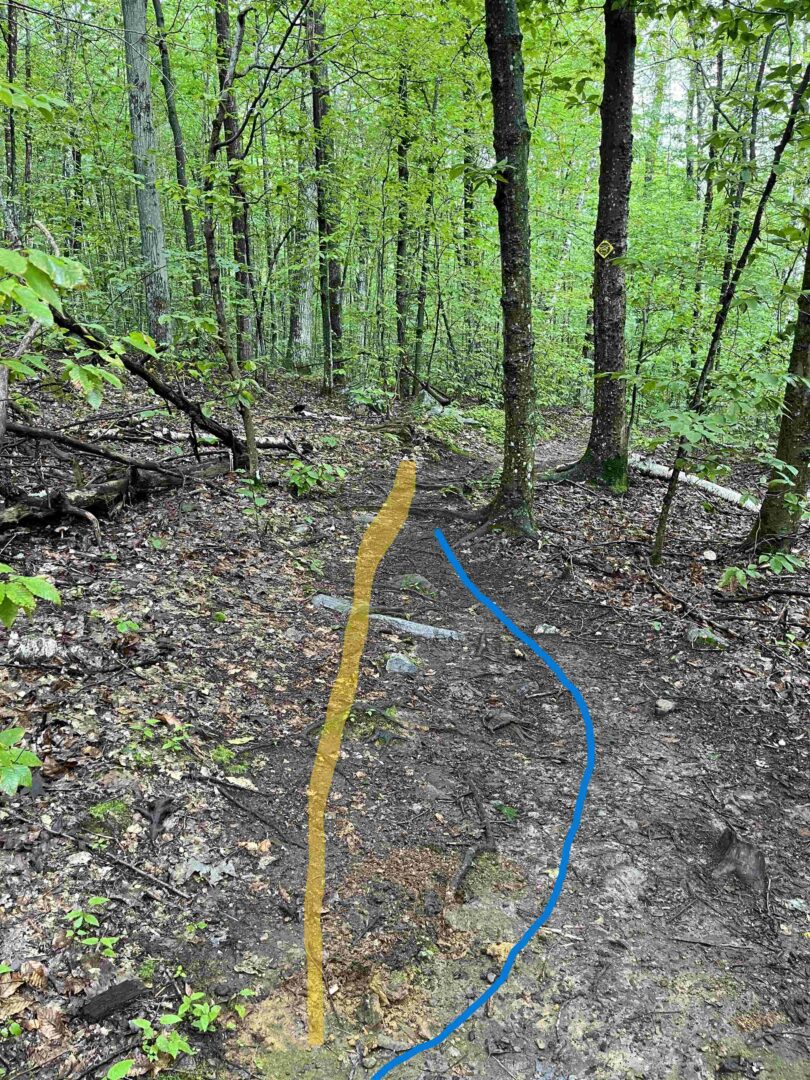
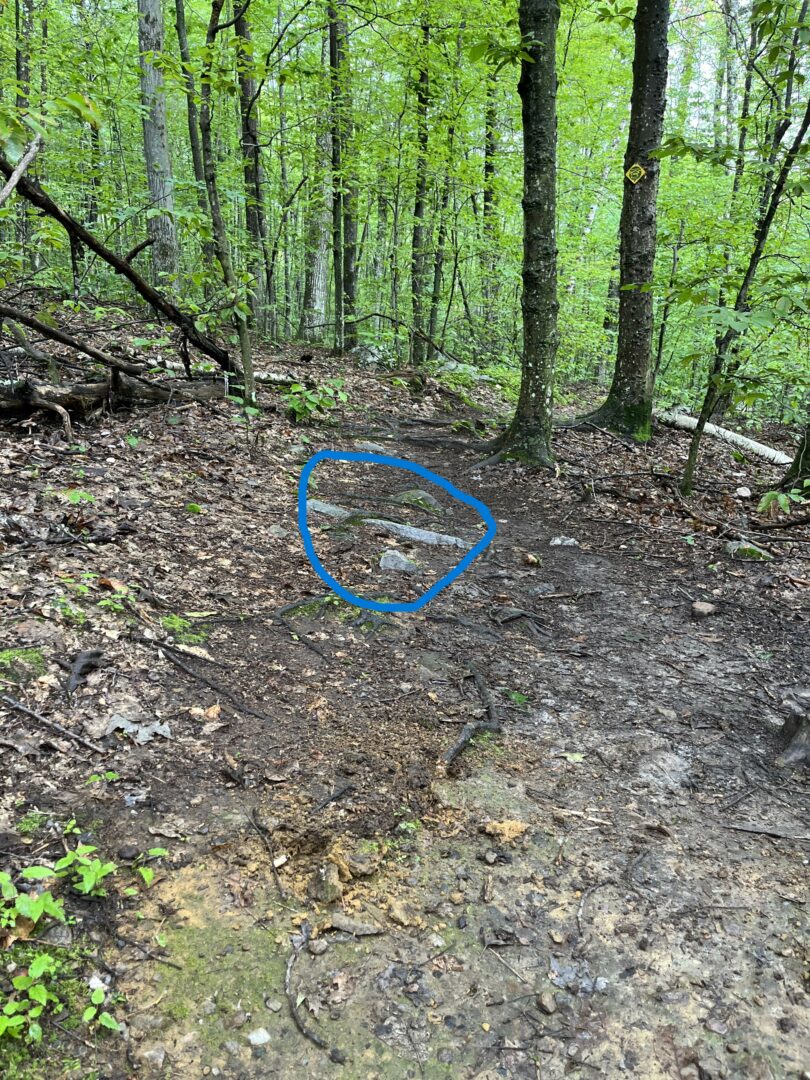
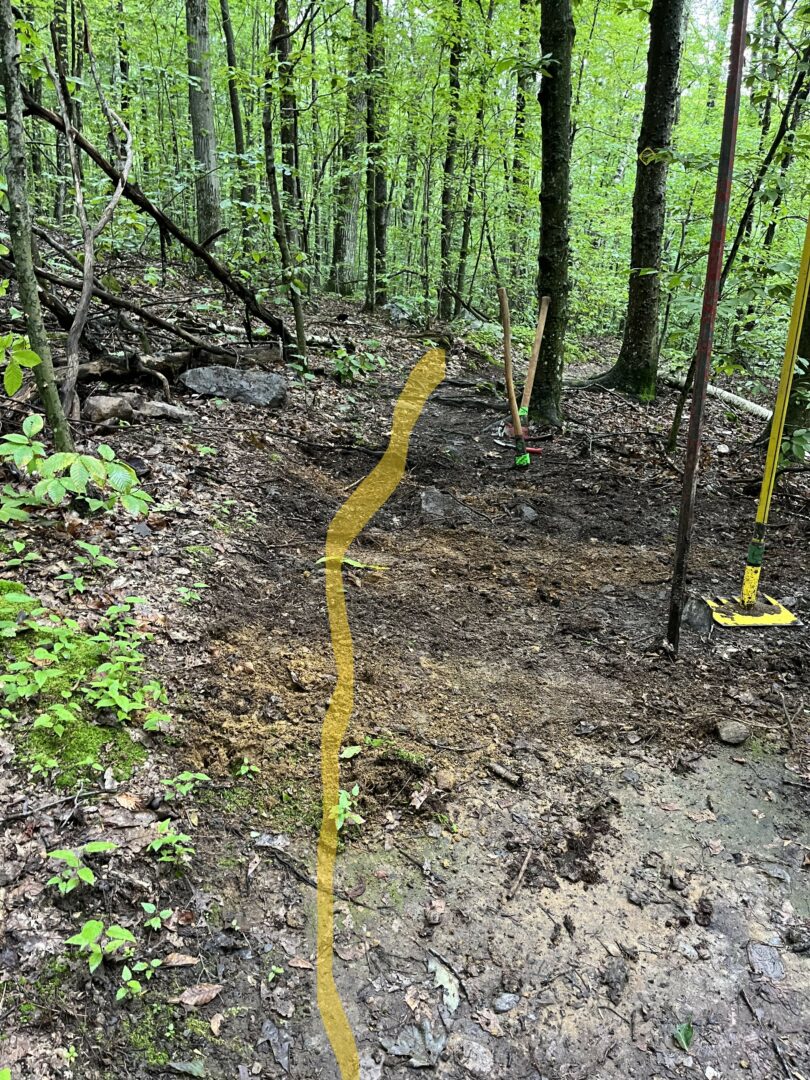
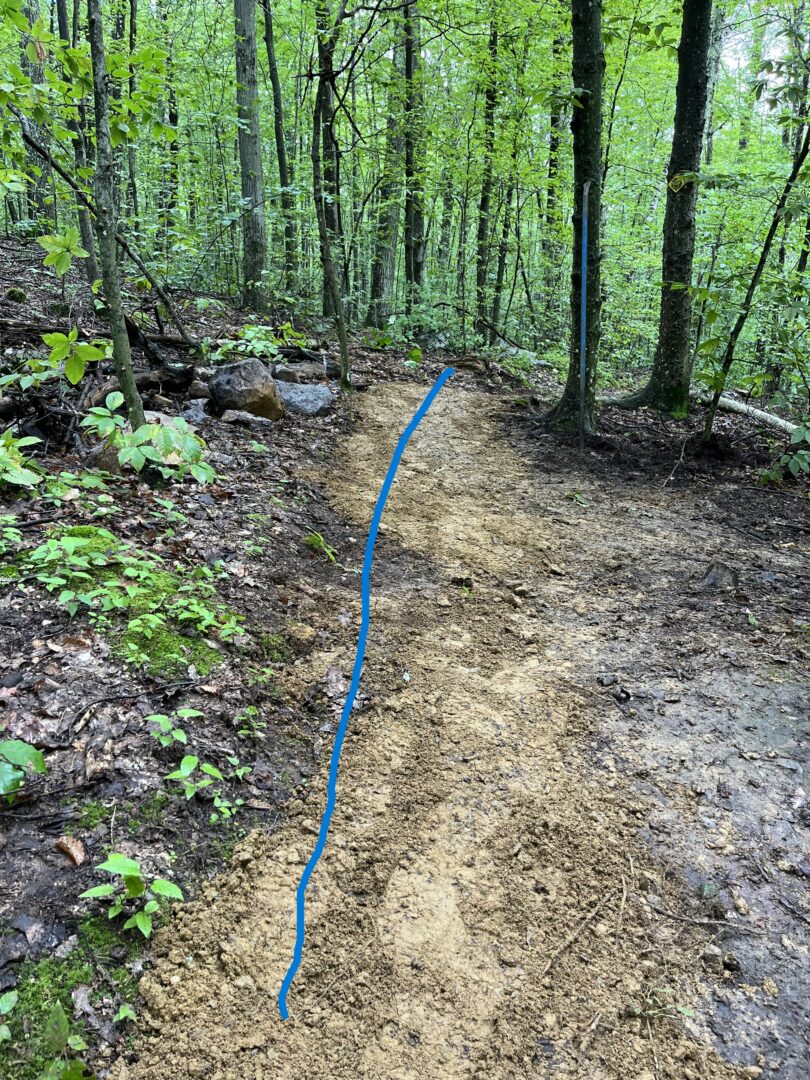
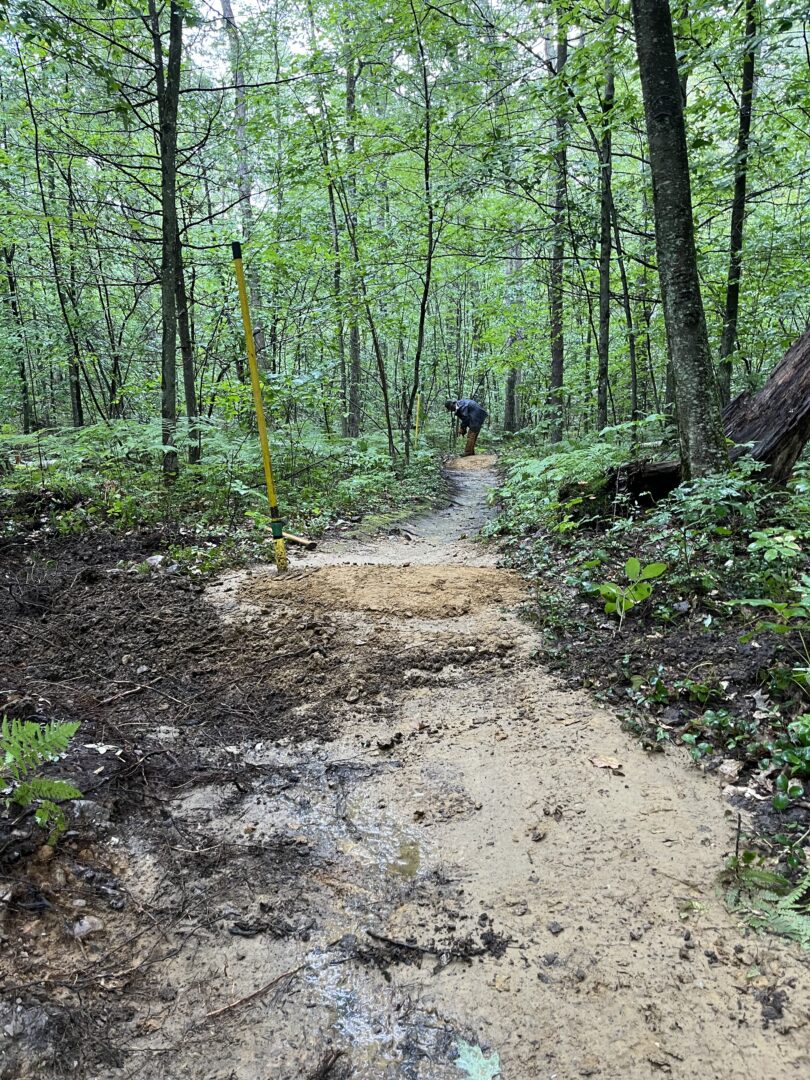
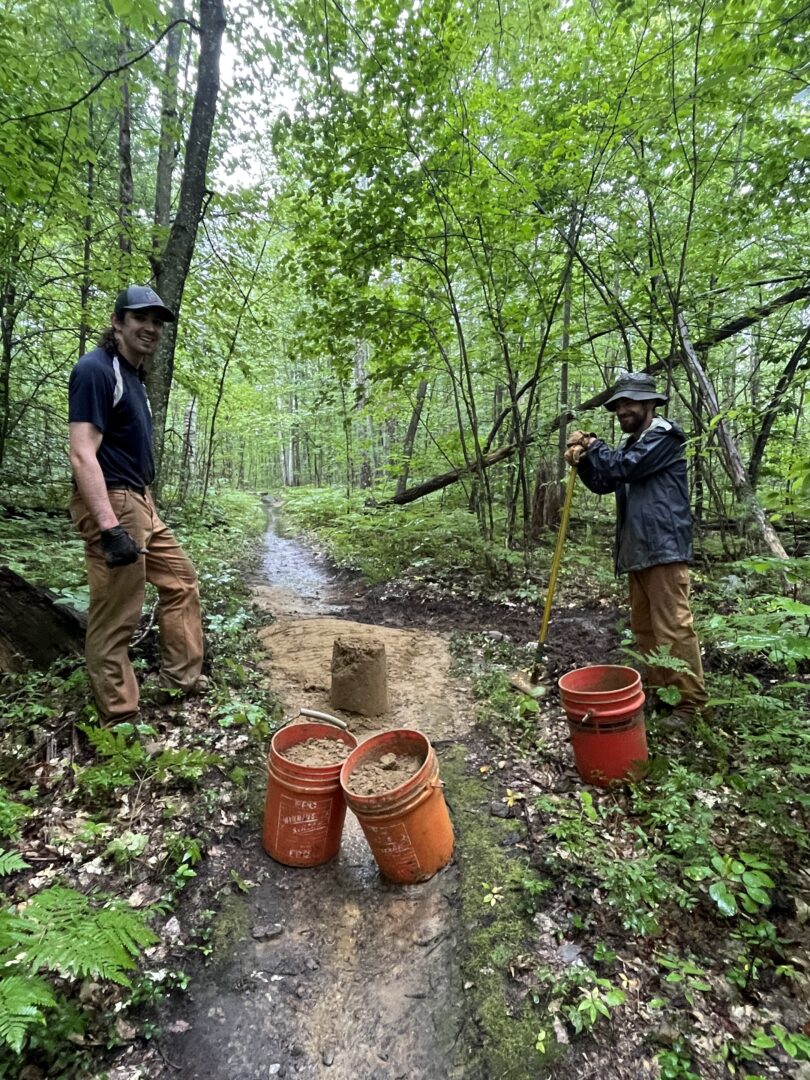
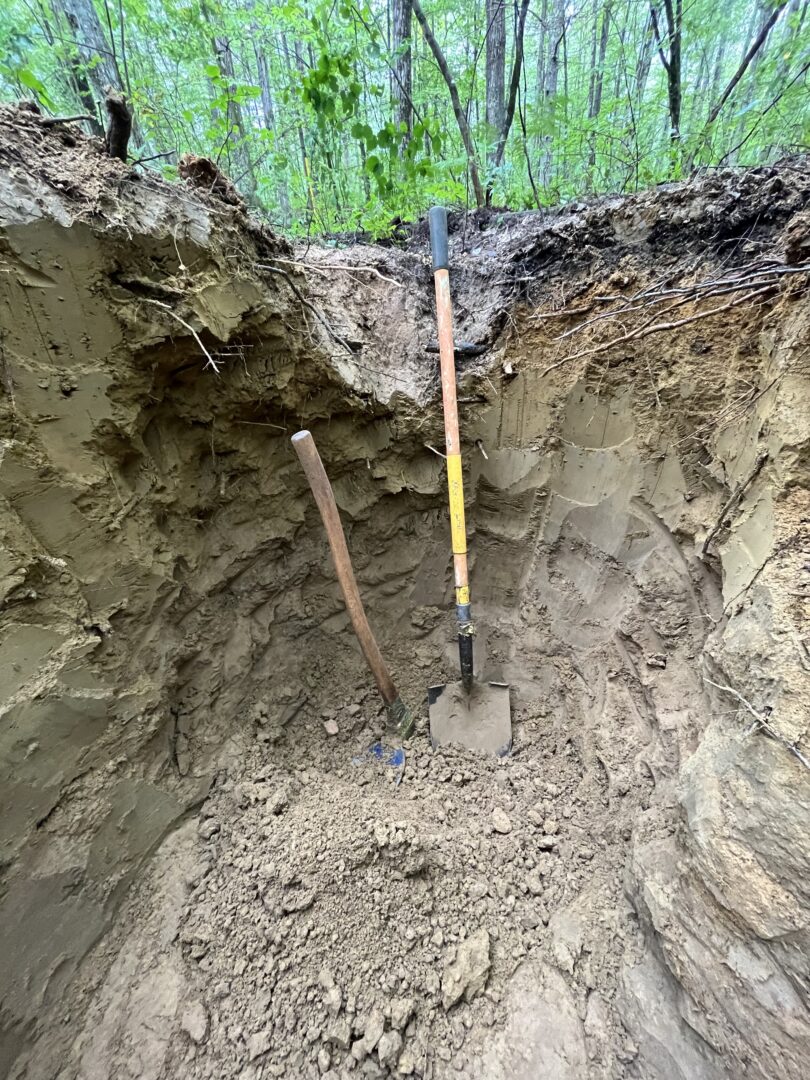
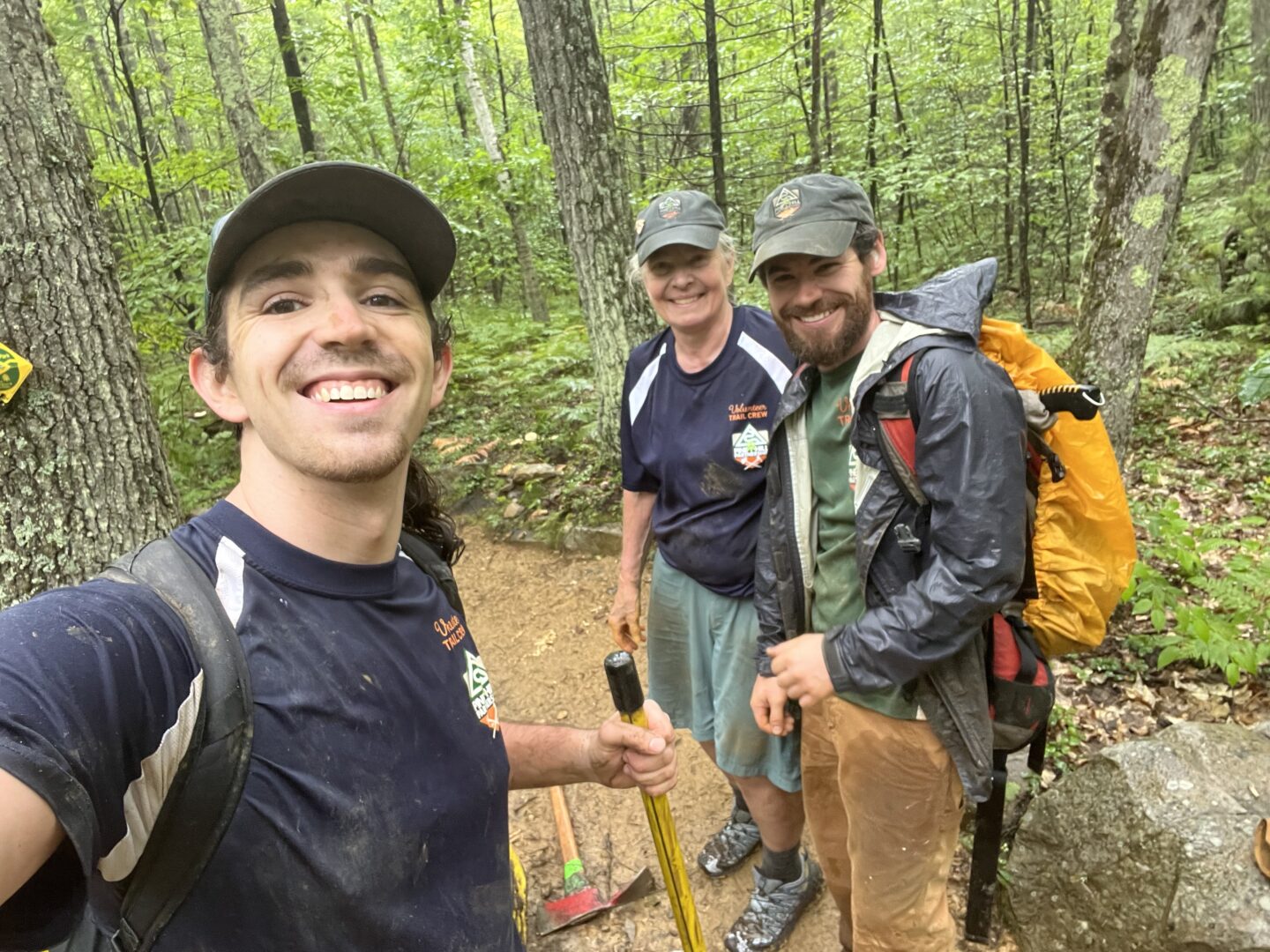
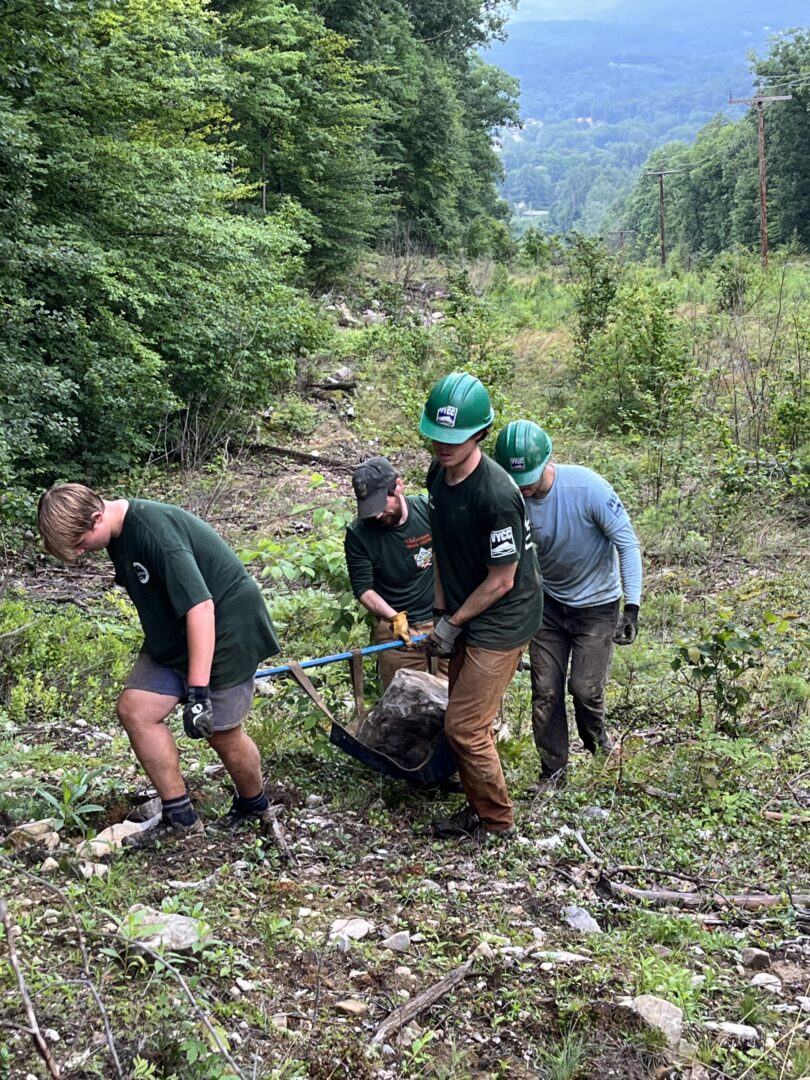
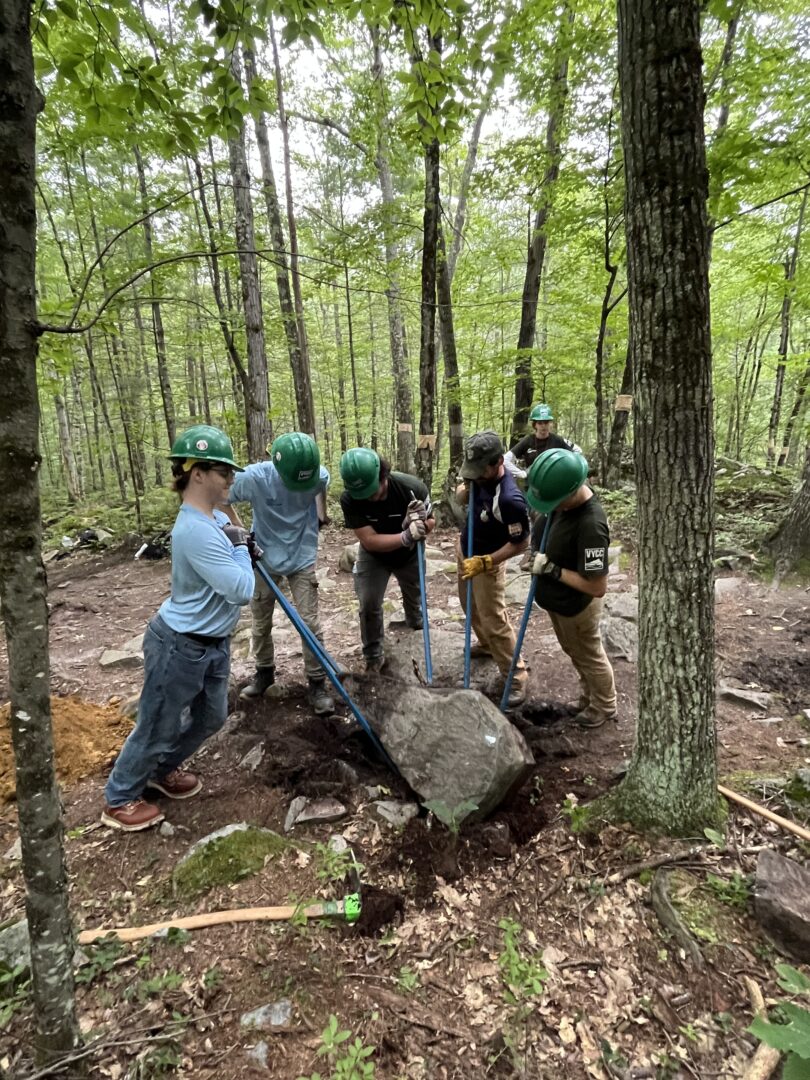
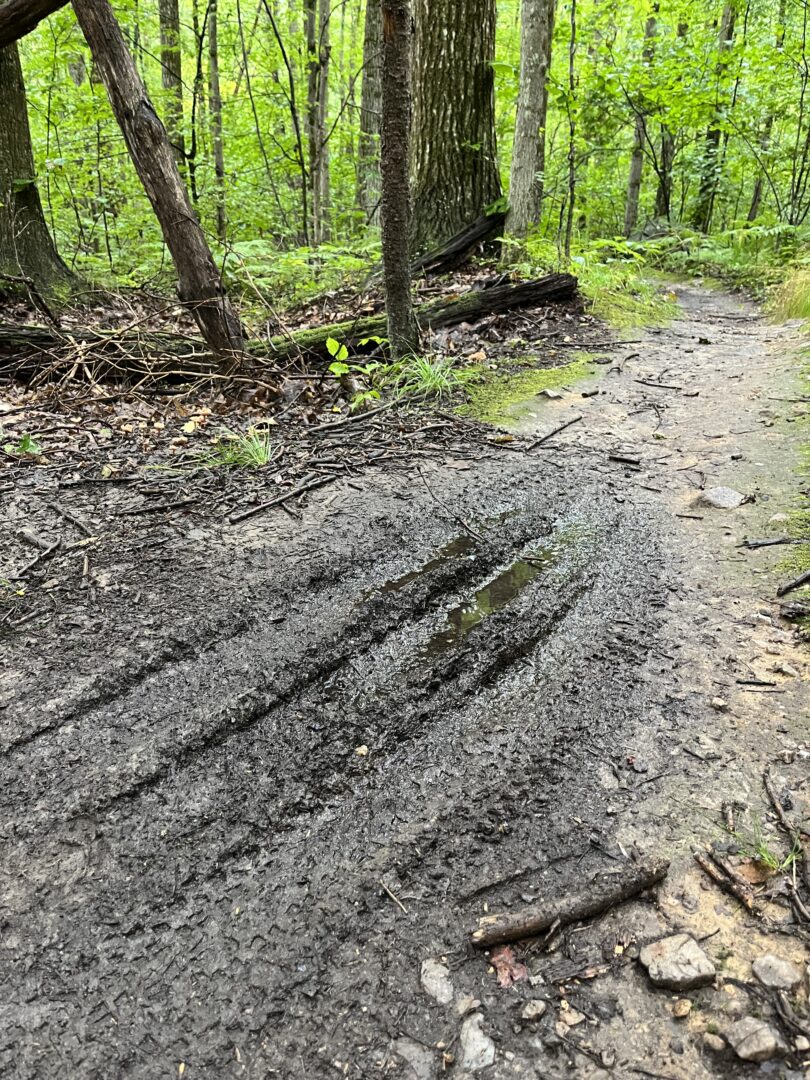
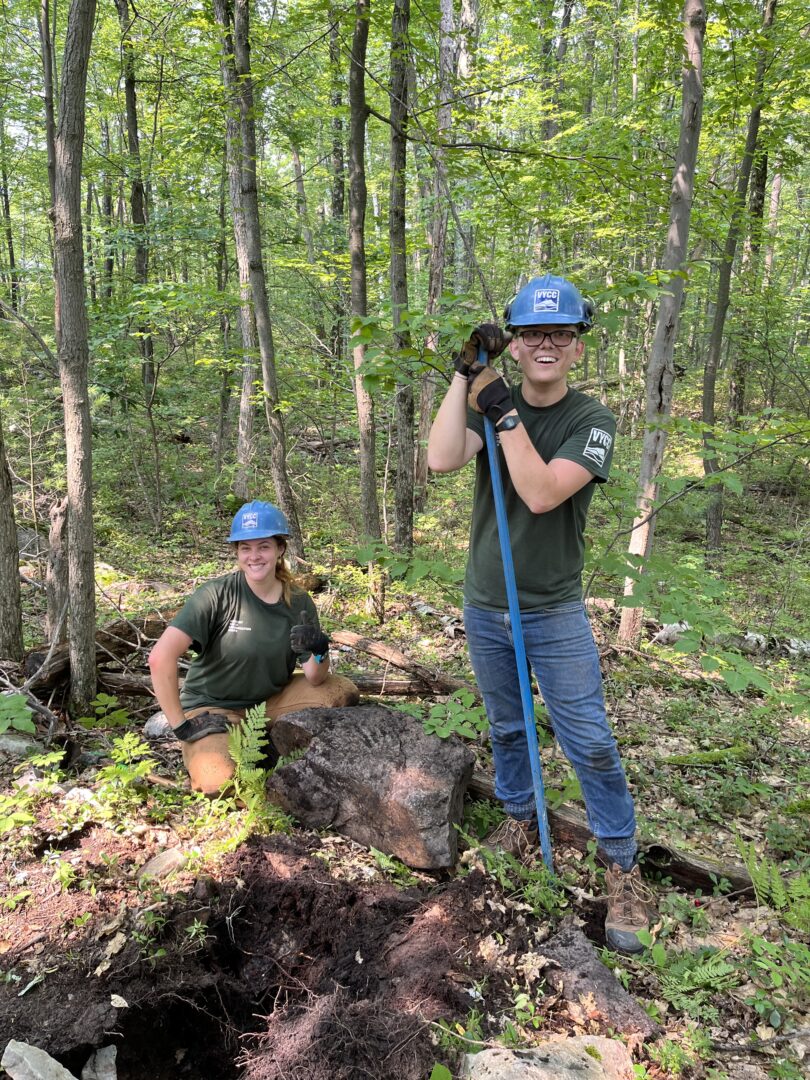
KSA Built has been in the park since the end of May. Rosey finished up Exit Strategy so we could get that open.
From Exit Strategy KSA Built moved to Casey’s Cross to put a culvert in to fix our perpetual mud area.
Broken Handlebar North was next up for a major tune up. The table top has been improved with an ‘A’ and ‘B’ line for an exit. The ‘B’ line jump at the bottom that flows really well. Further down the rock face there is now a ‘jump line’. Please look at this feature before attempting to hit it. There is no roll over it is a ‘jump’. The rest of Broken Handlebar North received a tune up as well with some hip jumps, log jump.
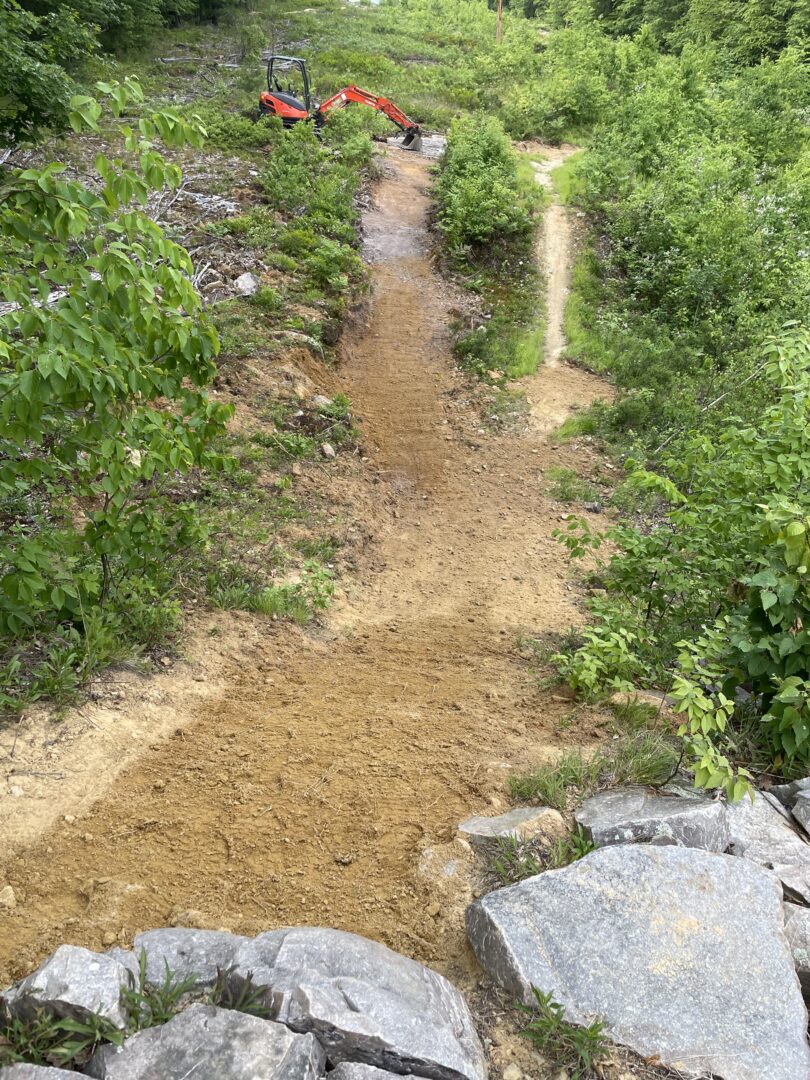
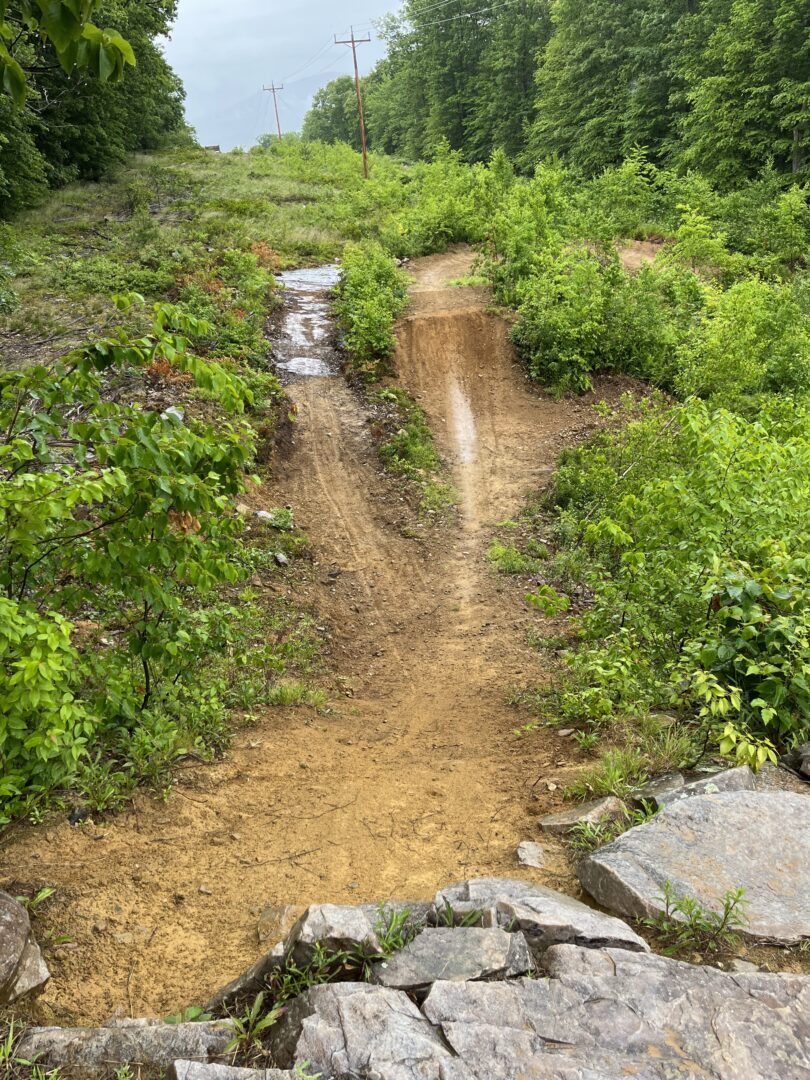
Table top above
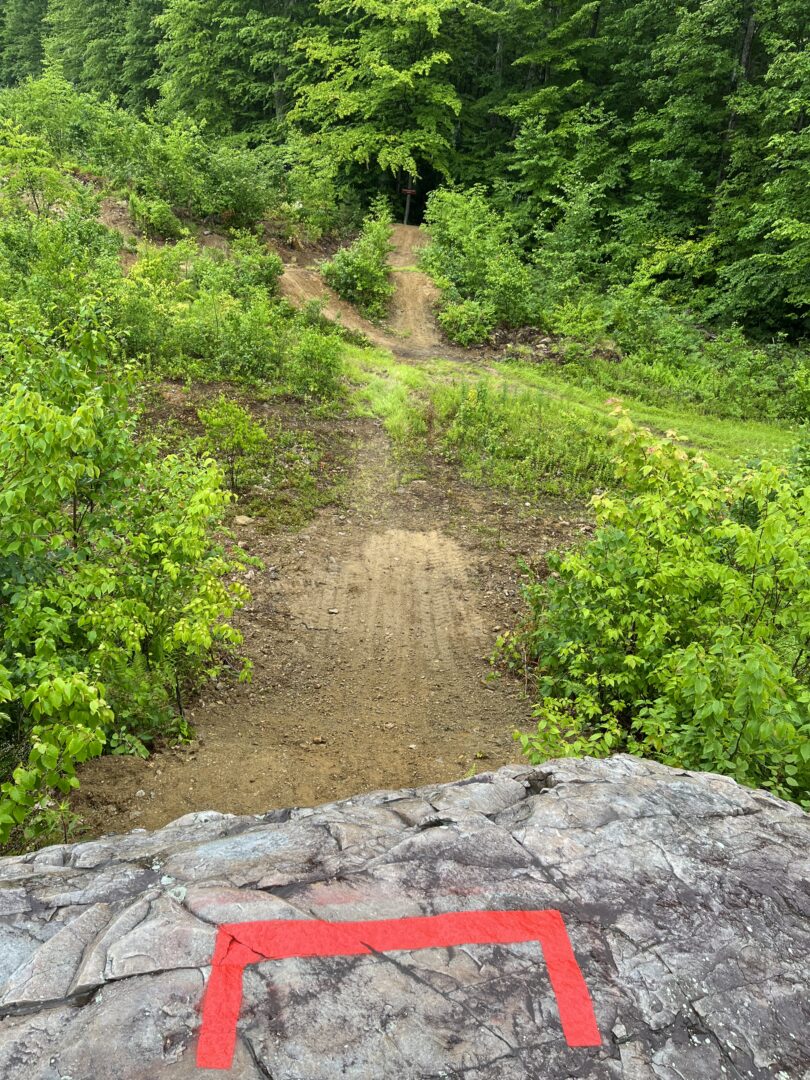
Jump line which does not have a roll off feature!
REMEMBER: Pre-ride, free-ride, re-ride!!! Broken Handlebar is not an easy access for first responders.
Rosey’s Rollover landing area received a little TLC. Next year the rest of this trail will be improved to make it more fun to ride.
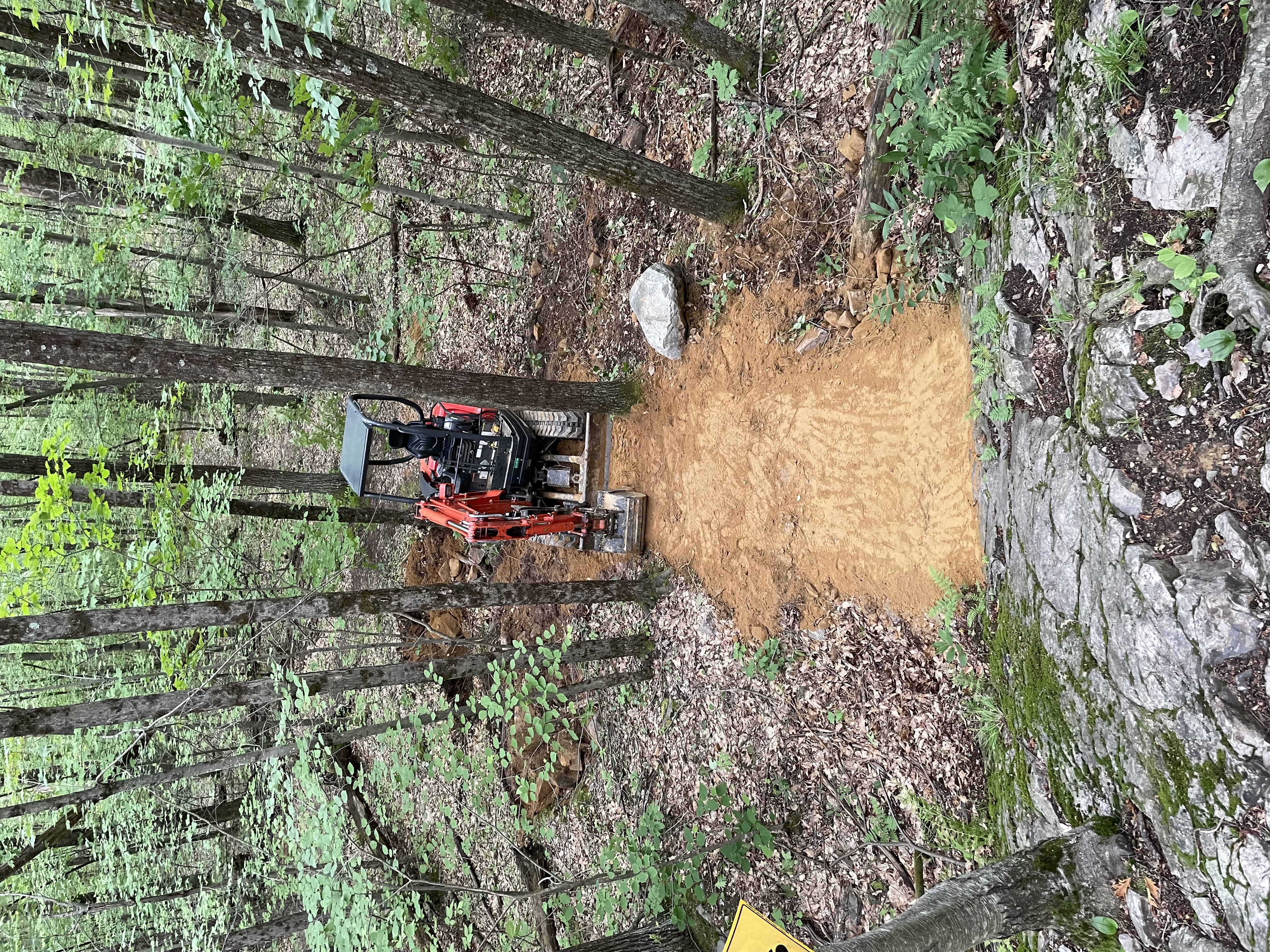
Upper Halfpipe has gotten a significant upgrade. Many of the features that had been built in 2008 all needed some TLC. Lower Halfpipe is getting tuned up as well.
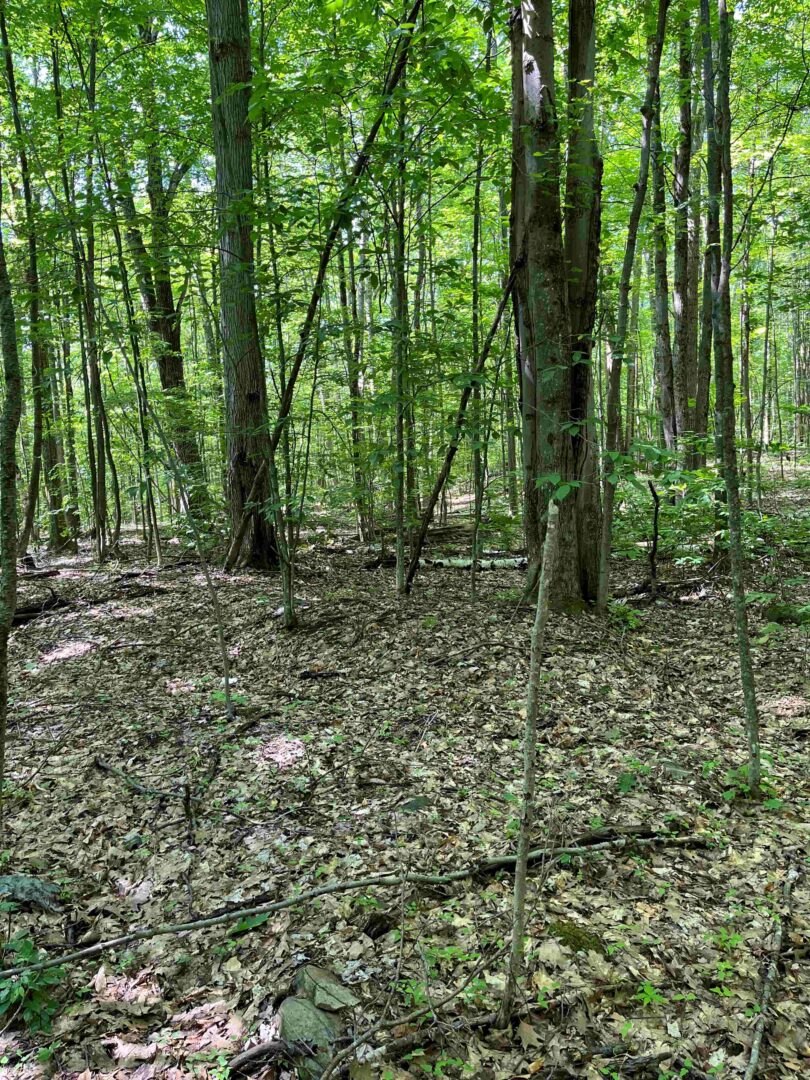
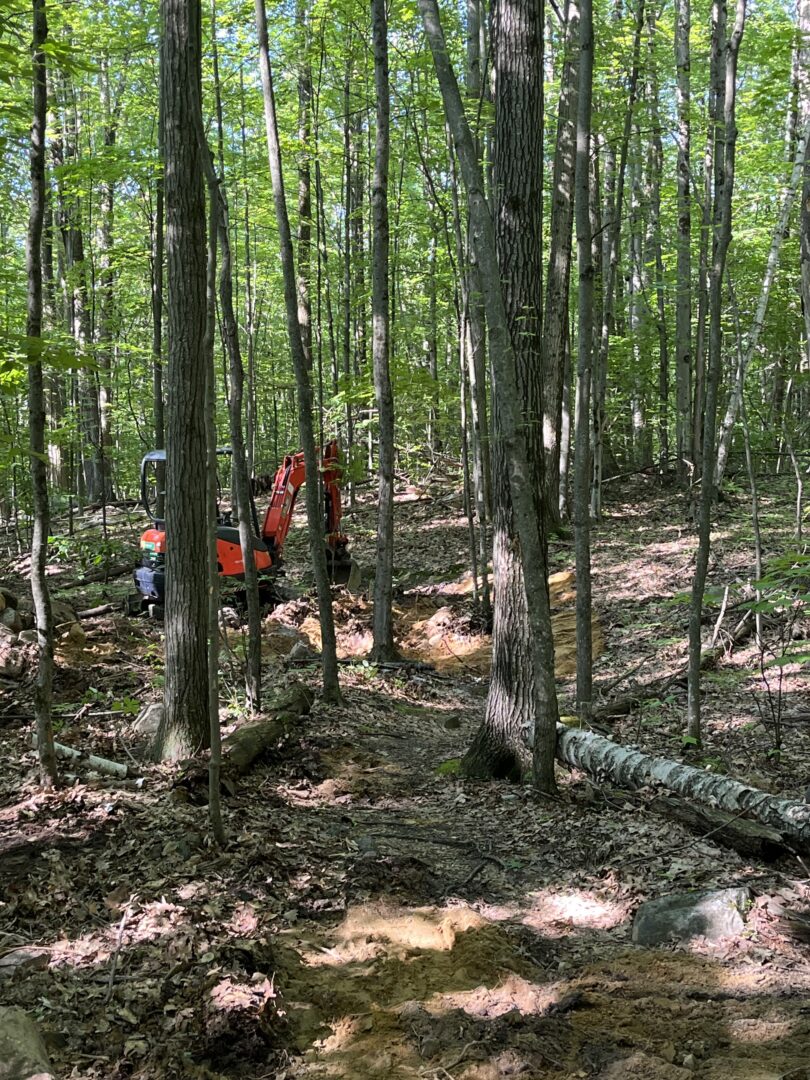
Upper Halfpipe getting a small reroute for better flow
Lower part of Furlough will have some drainage issues resolved. The water current runs straight down the trail tread which is not good for the trail.
Aaron’s Air will also receive some TLC before KSA Built leaves for the season.
All this repair work has been through an ERSA grant through the state. Pine Hill Partnership is paying out of pocket $11,000 as the quote and bid came in at different prices due to diesel being more expensive. Please consider becoming a member or making a contribution to help cover these costs. https://pinehillpartnership.org/membership/
Youth mountain bike group checking it out.
Tom had another great adventure in the park this spring:
The first day of spring found Rocky and Muddy ponds both still covered in ice. A crow, Northern Cardinal and Tufted Titmouse were the only birds seen on my walk that day. But I had the most fun setting up my trail cam in a rocky cliff face along the Carriage trail in an attempt to capture video of what I believed was a porcupine denning in the rocks. Porcupine tracks leading to the area, porcupine scat, and distinctive porcupine chew marks on nearby trees all led me to believe a porcupine was denning in the area.
A few days later on March 23rd, I went on an evening walk and, while standing along the shore of Rocky Pond, observed a dozen turkey vultures soaring high above the Ledges there, and then start to slowly descend one by one onto and amongst the rocks. This is something I have observed many times over the years, always around the Spring Equinox. It makes me wonder if that area was closed to the public(something I am NOT proposing) would turkey vultures nest there? This day was also the first time I observed robins in the park. And, of course, gray squirrels were busy scurrying around.
The next day, I noticed that most snow was now gone from the lower trails, but increases as you go up in elevation. Bird courtship behavior was becoming more evident, with two hairy woodpeckers observed fighting each other over a nearby female hairy woodpecker. It was the first day I felt that spring had finally arrived. Red-bellied woodpecker, hairy woodpecker, downy woodpecker, robin, tufted titmouse, black-capped chickadee, and white-breasted nuthatch were all observed. Both ponds were still completely frozen over with the exception of a small band of open water along Rocky Pond, and near the beaver dam on Muddy Pond. Eastern newts were seen in the open waters. Two pairs of Canada geese were seen in the open waters of Muddy Pond.
By March 26th, recent mild temperatures helped to melt snow, and there was much water flowing into Rocky Pond from the stream flowing under the walk bridge. The following morning walk was absolutely beautiful with my first seasonal sighting of chipmunks and Eastern bluebirds checking out the bird houses near the trail head. Song sparrows near the trailhead, red-shouldered hawks and broadwing hawks flying overhead, mallards and Canada geese at Muddy Pond, and a small pearl crescent butterfly flying about, all suggested that the great northern migration was underway.
On April 1st, I observed my first wild flower in the park, the Coltsfoot flower. Always the first flower to appear. Also observed my first mourning cloak butterfly, one of the first butterflies to appear in the park each early spring. Wood ducks, mallards, and Canada geese were seed at Rocky Pond and the Rocky Pond outlet area, a place I am sure wood ducks nest each year, though I’ve never seen an active nest there.
On April 3rd, Rocky Pond was finally ice free, and the forest was very quiet with only hairy woodpeckers and tufted titmouse being observed.
April 4th found nesting Canada geese, a dozen common mergansers, and a sleeping beaver all at Muddy Pond. A beautiful deer was seen near the 16A trail sign, and my trail cam showed a porcupine at that site on the Carriage Trail I had mentioned earlier.
A few days later, Eastern phoebes and a golden-crowned kinglet were seen for the first time in the park, and a pair of Osprey were seen at their nest platform at Muddy Pond. Eastern newts were mating at Rocky Pond.
As the days went by, more and more signs of spring were seen. Yellow-bellied sapsuckers had returned, a Cooper’s hawk was nesting in a tree along the 2nd Giorgetti trail, painted turtles were basking in the sun at Muddy Pond, and wood frogs were calling in the wetland area on the south side of Rocky Pond..
During the second week of April, trout lily started to appear on the forest floor, trailing arbutus and oak trees were now flowering, spring peepers and leopard frogs were calling, and hermit thrush were singing. Ring-necked ducks were seen at Muddy Pond. On April 15th I had the wits scared out of me when a ruffed grouse suddenly exploded into flight from a spot very close to where I was walking. So perfectly camouflaged are those birds.
During the third week of April, wood anemone, sedges, and barren strawberry were in flower.
A week later, I planted an American Chestnut tree seedling near Rocky Pond. The seedling came from a seed harvested by Mount St. Joseph Academy advanced biology students in the fall of 2022, and refrigerated until March of 2023. The students have been taking care of an orchard of 20 American chestnut trees since 2019 in the back of their school. In 2022, they harvested their first 27 viable American chestnut seeds, a first for a Vermont school.
During the first week of May you could find two-leaved toothwort, white violets, gay wings, bellwort, and wild strawberries all flowering. New birds seen included ovenbird and
yellow-throated vireo.
In Mid-May red eyed-vireos, house wrens, great blue heron, great crested flycatcher, and veery could be seen and heard, and flowers blooming included Solomon’s seal, false Solomon’s seal, wood betony, foam flower, and starflower.
During the last week of May I saw the beautiful northern oriole at Rocky Pond, the stunning indigo bunting at its usual nesting place underneath the power lines on Carriage Road near Rocky pond, and the breathtaking scarlet tanager in numerous places in the park.
Chestnut-sided warblers and American redstarts were back in good numbers. New flowers in bloom included common buttercup, early azalea, garlic mustard, and common cinquefoil.
During the first week of June I planted a new American chestnut seedling up at Rocky Pond to replace one that died over winter, and saw my first Viceroy and Eastern Swallowtail butterflies. The Viceroy is easily confused with the Monarch butterfly, but is smaller and has a black line across the lower part of its main wings.
During the second week of June you would likely see the following birds in the park: Song sparrow, Canada geese, great blue herons, wood ducks, common mergansers, tufted titmouse, American redstart, chestnut-sided warbler, red-eyed vireo, yellow-throated vireo, scarlet tanager, indigo bunting, Eastern towhee, ruby-throated hummingbird, catbird, yellow-bellied sapsucker, Eastern pewee, barred owls, hermit thrush, veery, and ovenbird. New flowers in bloom would include: common fleabane, ox-eye daisy, ragwort, sarsaparilla and moccasin flower.
On June 19th, I discovered a great blue heron nesting in the wetland area just behind the major inlet to Muddy Pond at the west end of the pond. I also saw my first White Admiral butterfly of the season..
That’s it for this issue. Please stay on the trails and enjoy observing the wildlife at Pine Hill Park.